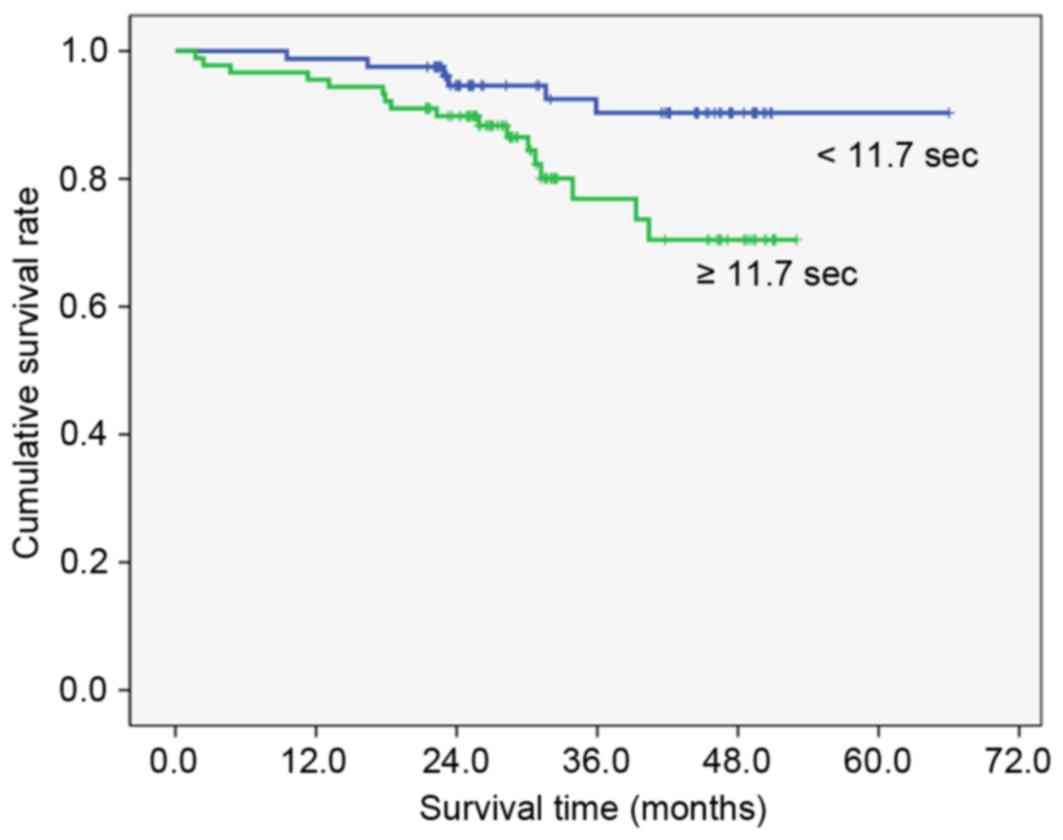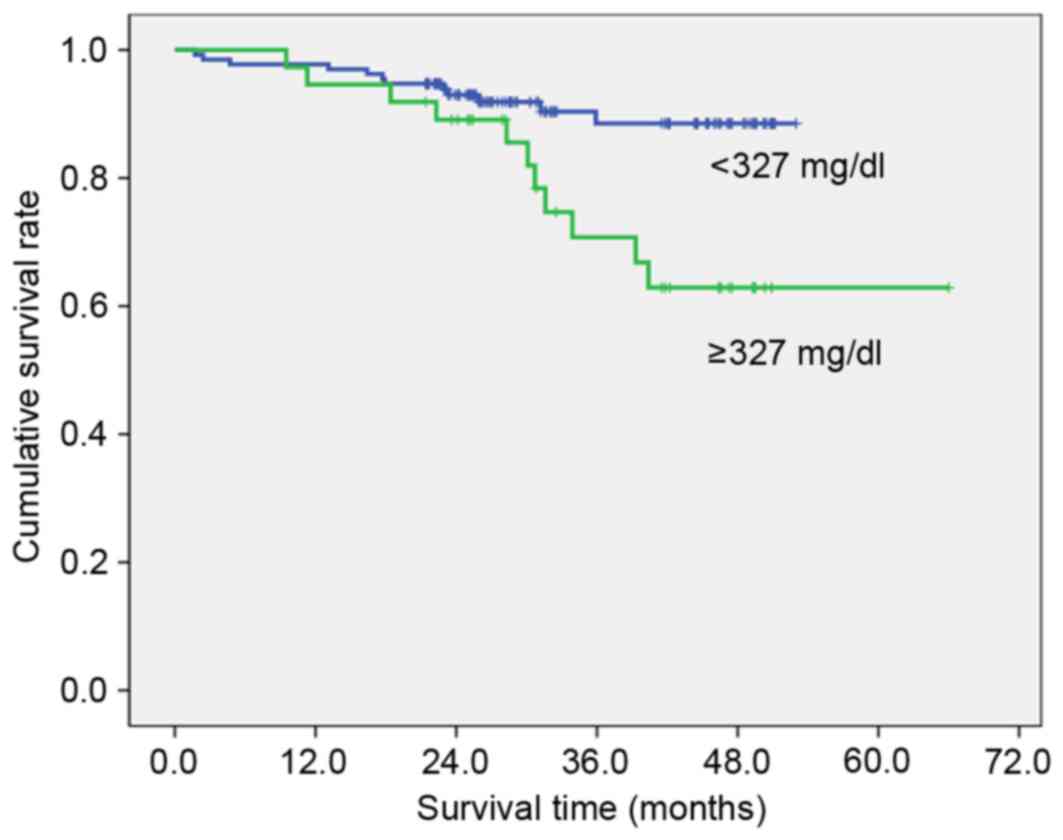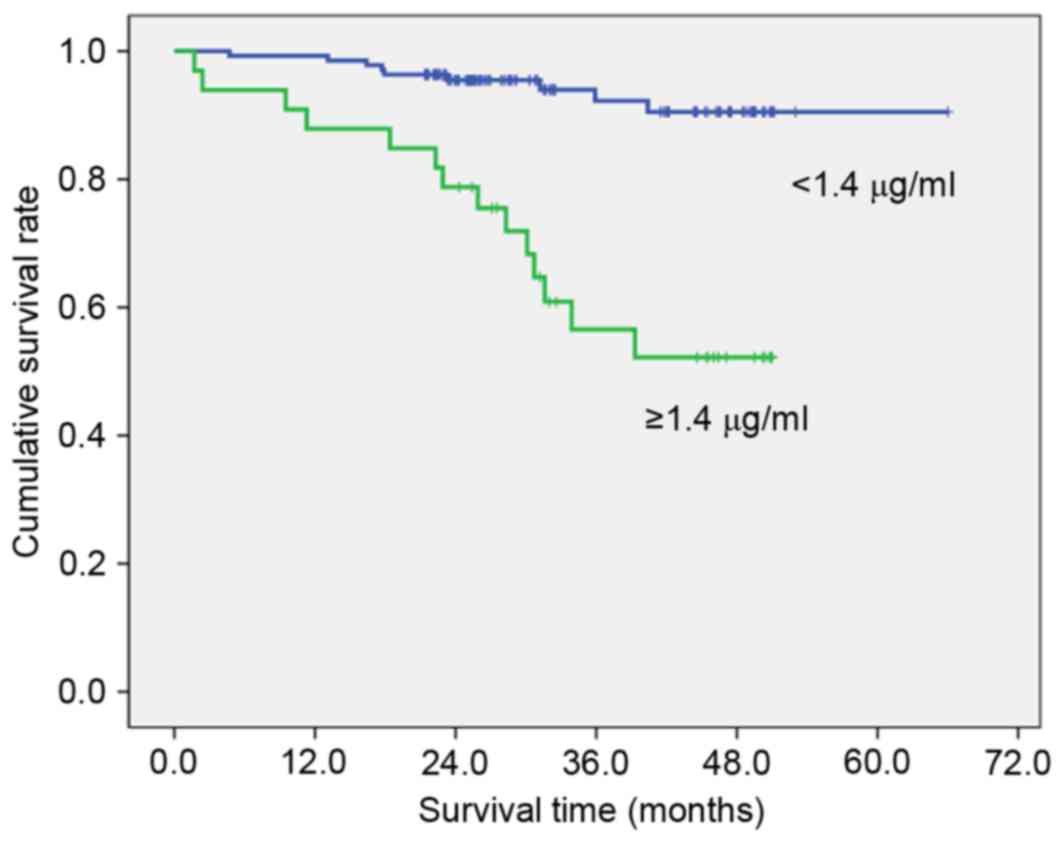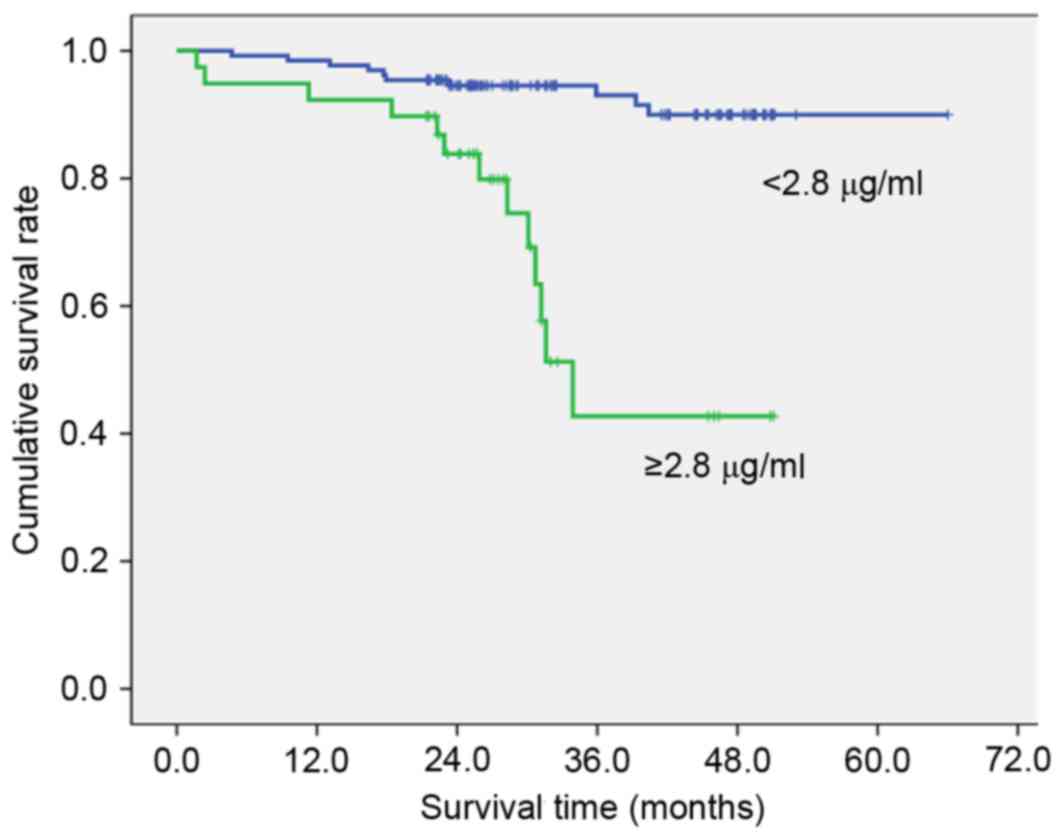|
1
|
Donati MB and Lorenzet R: Thrombosis and
cancer: 40 years of research. Thromb Res. 129:348–352. 2012.
View Article : Google Scholar : PubMed/NCBI
|
|
2
|
Wojtukiewicz MZ, Sierko E, Klementt P and
Rak J: The hemostatic system and angiogenesis in malignancy.
Neoplasia. 3:371–384. 2001. View Article : Google Scholar : PubMed/NCBI
|
|
3
|
Falanga A, Marchetti M and Vignoli A:
Coagulation and cancer: Biological and clinical aspects. J Thromb
Haemost. 11:223–233. 2013. View Article : Google Scholar : PubMed/NCBI
|
|
4
|
Coussens LM and Werb Z: Inflammation and
cancer. Nature. 420:860–867. 2002. View Article : Google Scholar : PubMed/NCBI
|
|
5
|
Falanga A, Russo L and Milesi V: The
coagulopathy of cancer. Curr Opin Hematol. 21:423–429. 2014.
View Article : Google Scholar : PubMed/NCBI
|
|
6
|
Ikeda M, Furukawa H, Imamura H, Shimizu J,
Ishida H, Masutani S, Tatsuta M and Satomi T: Poor prognosis
associated with thrombocytosis in patients with gastric cancer. Ann
Surg Oncol. 9:287–291. 2002. View Article : Google Scholar : PubMed/NCBI
|
|
7
|
Yamashita H, Kitayama J and Nagawa H:
Hyperfibrinogenemia is a useful predictor for lymphatic metastasis
in human gastric cancer. Jpn J Clin Oncol. 35:595–600. 2005.
View Article : Google Scholar : PubMed/NCBI
|
|
8
|
Yamashita H, Kitayama J, Kanno N, Yatomi Y
and Nagawa H: Hyperfibrinogenemia is associated with lymphatic as
well as hematogenous metastasis and worse clinical outcome in T2
gastric cancer. BMC Cancer. 6:1472006. View Article : Google Scholar : PubMed/NCBI
|
|
9
|
Yamashita H, Kitayama J, Ishikawa M and
Nagawa H: Tissue factor expression is a clinical indicator of
lymphatic metastasis and poor prognosis in gastric cancer with
intestinal phenotype. J Surg Oncol. 95:324–331. 2007. View Article : Google Scholar : PubMed/NCBI
|
|
10
|
Lee SE, Lee JH, Ryu KW, Nam BH, Cho SJ,
Lee JY, Kim CG, Choi IJ, Kook MC, Park SR and Kim YW: Preoperative
plasma fibrinogen level is a useful predictor of adjacent organ
involvement in patients with advanced gastric cancer. J Gastric
Cancer. 12:81–87. 2012. View Article : Google Scholar : PubMed/NCBI
|
|
11
|
Khorana AA, Ahrendt SA, Ryan CK, Francis
CW, Hruban RH, Hu YC, Hostetter G, Harvey J and Taubman MB: Tissue
factor expression, angiogenesis, and thrombosis in pancreatic
cancer. Clin Cancer Res. 13:2870–2875. 2007. View Article : Google Scholar : PubMed/NCBI
|
|
12
|
Joanne LY, May L, Lhotak V, Shahrzad S,
Shirasawa S, Weitz JI, Coomber BL, Mackman N and Rak JW: Oncogenic
events regulate tissue factor expression in colorectal cancer
cells: Implications for tumor progression and angiogenesis. Blood.
105:1734–1741. 2005. View Article : Google Scholar : PubMed/NCBI
|
|
13
|
Oya M, Akiyama Y, Okuyama T and Ishikawa
H: High preoperative plasma D-dimer level is associated with
advanced tumor stage and short survival after curative resection in
patients with colorectal cancer. Jpn J Clin Oncol. 31:388–394.
2001. View Article : Google Scholar : PubMed/NCBI
|
|
14
|
Dewys WD, Begg C, Lavin PT, Band PR,
Bennett JM, Bertino JR, Cohen MH, Douglass HO Jr, Engstrom PF,
Ezdinli EZ, et al: Prognostic effect of weight loss prior to
chemotherapy in cancer patients. Eastern Cooperative Oncology
Group. Am J Med. 69:491–497. 1980. View Article : Google Scholar : PubMed/NCBI
|
|
15
|
UICC, . TNM Classification of Malignant
Tumours. 7th. Wiley & Liss; New York: 2009
|
|
16
|
Gouin-Thibault I and Samama MM: Laboratory
diagnosis of the thrombophilic state in cancer patients. Semin
Thromb Hemost. 25:167–172. 1999. View Article : Google Scholar : PubMed/NCBI
|
|
17
|
Lima LG and Monteiro RQ: Activation of
blood coagulation in cancer: Implications for tumour progression.
Biosci Rep. 33:e000642013. View Article : Google Scholar : PubMed/NCBI
|
|
18
|
Balkwill F and Mantovani A: Inflammation
and cancer: Back to Virchow? Lancet. 357:539–545. 2001. View Article : Google Scholar : PubMed/NCBI
|
|
19
|
Wang X, Wang E, Kavanagh JJ and Freedman
RS: Ovarian cancer, the coagulation pathway, and inflammation. J
Transl Med. 3:252005. View Article : Google Scholar : PubMed/NCBI
|
|
20
|
Tang L, Liu K, Wang J, Wang C, Zhao P and
Liu J: High preoperative plasma fibrinogen levels are associated
with distant metastases and impaired prognosis after curative
resection in patients with colorectal cancer. J Surg Oncol.
102:428–432. 2010. View Article : Google Scholar : PubMed/NCBI
|
|
21
|
Tennent GA, Brennan SO, Stangou AJ,
O'Grady J, Hawkins PN and Pepys MB: Human plasma fibrinogen is
synthesized in the liver. Blood. 109:1971–1974. 2007. View Article : Google Scholar : PubMed/NCBI
|
|
22
|
Sahni A, SimpsonHaidaris P, Sahni S, Vaday
G and Francis C: Fibrinogen synthesized by cancer cells augments
the proliferative effect of fibroblast growth factor-2 (FGF-2). J
Thromb Haemost. 6:176–183. 2008. View Article : Google Scholar : PubMed/NCBI
|
|
23
|
Guadiz G, Sporn LA and Simpson-Haidaris
PJ: Thrombin cleavage-independent deposition of fibrinogen in
extracellular matrices. Blood. 90:2644–2653. 1997.PubMed/NCBI
|
|
24
|
Takeuchi H, Ikeuchi S, Kitagawa Y, Shimada
A, Oishi T, Isobe Y, Kubochi K, Kitajima M and Matsumoto S:
Pretreatment plasma fibrinogen level correlates with tumor
progression and metastasis in patients with squamous cell carcinoma
of the esophagus. J Gastroenterol Hepatol. 22:2222–2227. 2007.
View Article : Google Scholar : PubMed/NCBI
|
|
25
|
Polterauer S, Seebacher V,
Hefler-Frischmuth K, Grimm C, Heinze G, Tempfer C, Reinthaller A
and Hefler L: Fibrinogen plasma levels are an independent
prognostic parameter in patients with cervical cancer. Am J Obstet
Gynecol. 200:647.e1–e7. 2009. View Article : Google Scholar
|
|
26
|
Polterauer S, Grimm C, Seebacher V, Concin
N, Marth C, Tomovski C, Husslein H, Leipold H, Hefler-Frischmuth K,
Tempfer C, et al: Plasma fibrinogen levels and prognosis in
patients with ovarian cancer: A multicenter study. Oncologist.
14:979–985. 2009. View Article : Google Scholar : PubMed/NCBI
|
|
27
|
Li Y, Wei S, Wang J, Hong L, Cui L and
Wang C: Analysis of the factors associated with abnormal
coagulation and prognosis in patients with non-small cell lung
cancer. Zhongguo Fei Ai Za Zhi. 17:789–796. 2014.(In Chinese).
PubMed/NCBI
|
|
28
|
Ma Y, Qian Y and Lv W: The correlation
between plasma fibrinogen levels and the clinical features of
patients with ovarian carcinoma. J Int Med Res. 35:678–684. 2007.
View Article : Google Scholar : PubMed/NCBI
|
|
29
|
Liu L, Zhang X, Yan B, Gu Q, Zhang X, Jiao
J, Sun D, Wang N and Yue X: Elevated plasma D-dimer levels
correlate with long term survival of gastric cancer patients. PloS
One. 9:e905472014. View Article : Google Scholar : PubMed/NCBI
|
|
30
|
Yamamoto M, Yoshinaga K, Matsuyama A,
Iwasa T, Osoegawa A, Tsujita E, Yamashita Y, Tsutsui S and Ishida
T: Plasma D-dimer level as a mortality predictor in patients with
advanced or recurrent colorectal cancer. Oncology. 83:10–15. 2012.
View Article : Google Scholar : PubMed/NCBI
|
|
31
|
Fukumoto K, Taniguchi T, Usami N,
Kawaguchi K, Fukui T, Ishiguro F, Nakamura S and Yokoi K: The
preoperative plasma D-dimer level is an independent prognostic
factor in patients with completely resected non-small cell lung
cancer. Surg Today. 45:63–67. 2015. View Article : Google Scholar : PubMed/NCBI
|
|
32
|
İnal T, Anar C, Polat G, Ünsal İ and
Halilçolar H: The prognostic value of D-dimer in lung cancer. Clin
Respir J. 9:305–313. 2015. View Article : Google Scholar : PubMed/NCBI
|
|
33
|
Man YN, Wang YN, Hao J, Liu X, Liu C, Zhu
C and Wu XZ: Pretreatment plasma D-dimer, fibrinogen and platelet
levels significantly impact prognosis in patients with epithelial
ovarian cancer independently of venous thromboembolism. Int J
Gynecol Cancer. 25:24–32. 2015. View Article : Google Scholar : PubMed/NCBI
|
|
34
|
Blackwell K, Haroon Z, Broadwater G, Berry
D, Harris L, Iglehart JD, Dewhirst M and Greenberg C: Plasma
D-dimer levels in operable breast cancer patients correlate with
clinical stage and axillary lymph node status. J Clin Oncol.
18:600–608. 2000. View Article : Google Scholar : PubMed/NCBI
|
|
35
|
Li FX, Wei LJ, Zhang H, Li SX and Liu JT:
Significance of thrombocytosis in clinicopathologic characteristics
and prognosis of gastric cancer. Asian Pac J Cancer Prev.
15:6511–6517. 2014. View Article : Google Scholar : PubMed/NCBI
|
|
36
|
Li Y, Miao LY, Xiao YL, Cai HR and Zhang
DP: Elevated platelets enhance cancer cell migration, promote
hematogenous metastasis and associate with a poor prognosis in
advanced non-small cell lung cancer cases. Asian Pac J Cancer Prev.
15:139–143. 2014. View Article : Google Scholar : PubMed/NCBI
|
|
37
|
Heng S and Benjapibal M: Preoperative
thrombocytosis and poor prognostic factors in endometrial cancer.
Asian Pac J Cancer Prev. 15:10231–10236. 2014. View Article : Google Scholar : PubMed/NCBI
|
|
38
|
Sasaki K, Kawai K, Tsuno NH, Sunami E and
Kitayama J: Impact of preoperative thrombocytosis on the survival
of patients with primary colorectal cancer. World J Surg.
36:192–200. 2012. View Article : Google Scholar : PubMed/NCBI
|
|
39
|
Di Micco P, Romano M, Niglio A, Nozzolillo
P, Federico A, Petronella P, Nunziata L, Di Micco B and Torella R:
Alteration of haemostasis in non-metastatic gastric cancer. Dig
Liver Dis. 33:546–550. 2001. View Article : Google Scholar : PubMed/NCBI
|
|
40
|
Ferrigno D, Buccheri G and Ricca I:
Prognostic significance of blood coagulation tests in lung cancer.
Eur Respir J. 17:667–673. 2001. View Article : Google Scholar : PubMed/NCBI
|
|
41
|
Kılıc M, Yoldas O, Keskek M, Ertan T, Tez
M, Gocmen E and Koc M: Prognostic value of plasma D-dimer levels in
patients with colorectal cancer. Colorectal Dis. 10:238–241. 2008.
View Article : Google Scholar : PubMed/NCBI
|
|
42
|
Südhoff T and Schneider W: Fibrinolytic
mechanisms in tumor growth and spreading. Clin Investig.
70:631–636. 1992. View Article : Google Scholar : PubMed/NCBI
|
|
43
|
Lykke J and Nielsen HJ: Haemostatic
alterations in colorectal cancer: Perspectives for future
treatment. J Surg Oncol. 88:269–275. 2004. View Article : Google Scholar : PubMed/NCBI
|
|
44
|
Bugge TH, Kombrinck KW, Xiao Q, Holmbäck
K, Daugherty CC, Witte DP and Degen JL: Growth and dissemination of
Lewis lung carcinoma in plasminogen-deficient mice. Blood.
90:4522–4531. 1997.PubMed/NCBI
|
|
45
|
Svendsen MN, Werther K, Nielsen HJ and
Kristjansen PE: VEGF and tumour angiogenesis. Impact of surgery,
wound healing, inflammation and blood transfusion. Scand J
Gastroenterol. 37:373–379. 2002. View Article : Google Scholar : PubMed/NCBI
|













